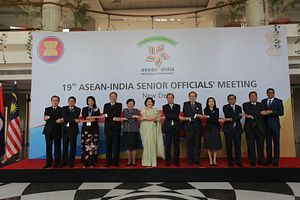At the ninth edition of Delhi Dialogue, held in New Delhi on July 4 to 5, External Affairs Minister Sushma Swaraj reiterated India’s benign role in the Asia-Pacific. She mentioned that India’s influence on Southeast Asia did not occur through “conquest or colonization.” Swaraj was taking part in the Track 1.5 meeting involving India and the members of the Association of Southeast Asian Nations (ASEAN) as both sides celebrate the 25th anniversary of their dialogue partnership this year.
India started engaging with ASEAN in 1992 through a sectoral dialogue partnership. In 1996, India was welcomed as a full dialogue partner. In the subsequent years and decades, India joined the ASEAN Regional Forum (ARF), East Asia Summit (EAS), ASEAN Defense Ministers Meeting Plus (ADMM Plus), Expanded ASEAN Maritime Forum (EAMF), and several other platforms commonly shared with ASEAN. In the meantime, India was proactive in articulating its Look East Policy through the Bay of Bengal Initiative for Multisectoral Technical and Economic Cooperation (BIMSTEC) and Mekong Ganga Cooperation (MGC) in the late 1990s.
Together India and ASEAN account for almost one-third of the global population (i.e. 1.85 billion people) and a combined GDP of approximately $3.8 trillion. Together they would form the third largest economy in the world. Given their combined clout, it is only natural for both India and ASEAN to continue to walk side by side in areas including space technology, counterterrorism and anti-insurgency operations, trade and investment, connectivity, maritime security, and all other issues of common concerns.
The Delhi Dialogue recapped these institutional efforts from India and their concrete results. India’s two-way trade with ASEAN now stands at approximately $76 billion and India is also a part of the ASEAN-led Regional Comprehensive Economic Partnership (RCEP), which, if implemented, will cover almost 40 percent of the total world trade. Speakers at the dialogue particularly focused on the potential of the small and medium size enterprises (SMEs) for boosting economic cooperation, primarily due to the large roles SMEs play in countries like Vietnam and the Philippines.
Swaraj reinforced on the importance of the “3 Cs” — connectivity, commerce, and culture — in her keynote speech. In that direction, the idea of Panchdhara was mooted by Minister of Foreign Affairs Virasakdi Futrakul, which refers to an improved version of the MGC to include five river systems from India and ASEAN countries: the Ganga, Brahmaputra, Irrawaddy, Chao Phraya, and Mekong. The aim would be enhancing people-to-people connectivity and nourishing the civilizational linkages within the region. The soft power aspects of India’s Act East Policy play the role of a bridge connecting the two regions. Hence, ideas have been developed to cultivate intraregional tourism, educational cooperation, and the potential of Indian diaspora in Southeast Asia. The importance of studying the pattern of reverse flows of cultural and historical inspiration from Southeast Asia to India was discussed too.
In terms of physical connectivity, recent developments in India-Myanmar-Thailand (IMT) Trilateral Highway and Kaladan Multimodal Transit and Transport Project were mentioned and the problems in their implementation identified. The dialogue reinforced that a few of the recent hiccups in executing the IMT Highway project have emerged from Myanmar, as the new government in the country is revisiting the agreements and MoUs signed by the previous administration. Still, the Thai side appeared hopeful about the completion of the IMT Highway in another 18 months.
At the sideline of the dialogue, Swaraj also had a bilateral meeting with the deputy prime minister and minister for foreign affairs of Vietnam, Pham Binh Minh. Both ministers stressed the importance of adherence to the international laws and regulations to maintain peace, prosperity, and stability in the oceans and on the land. Vietnam’s significance in India’s strategic ambitions in the region is now a reality, especially in the context of China’s assertiveness in South, Southeast, and East Asia. Vietnam also extended its support for India’s claim for a permanent seat in an expanded United Nations Security Council (UNSC).
Swaraj’s bilateral meeting pointed to a crucial theme of the dialogue: that fulfillment of India’s geostrategic interests in the Indo-Pacific region depend on India’s bilateral and multilateral/regional engagements with the countries in the region. That is why maintaining cordiality with ASEAN as an organisation on the one hand and with the individual Southeast Asian countries on the other hand remains crucial for India.
Dr. Sampa Kundu works with the Institute for Defense Studies and Analyses, New Delhi.

































